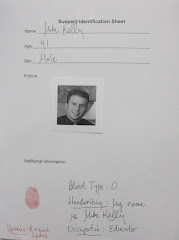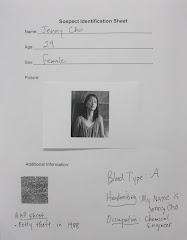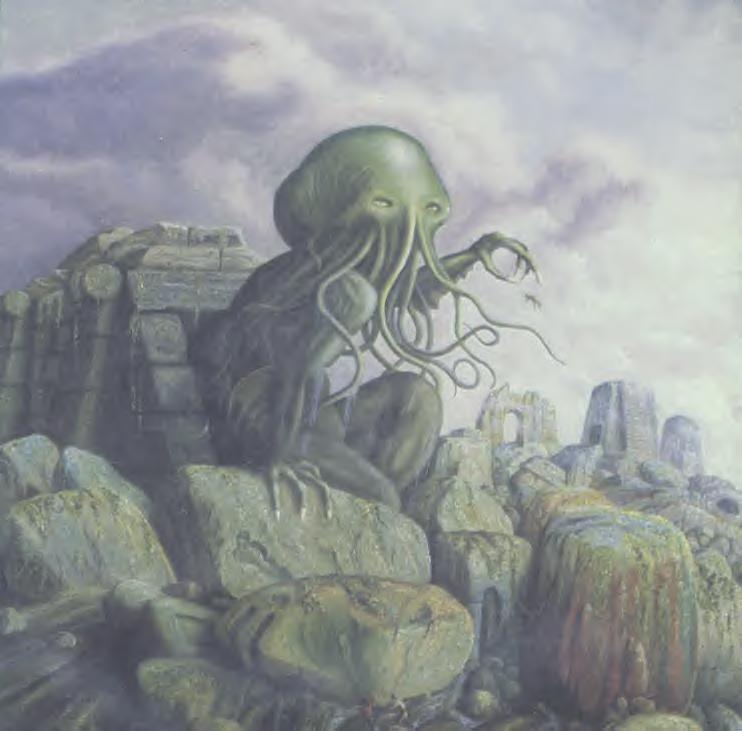Monday, September 7, 2009
Crime Scene Investigation
Blood Typing
1. Outline the Major Types of Blood.
A: Has a B Antibody and an A Antigen.
B: Has an A Antibody and a B Antigen.
AB: Has both A and B Antibodies, but neither Antigen. The "Universal Recipient".
O: Has neither Antibody, but both A and B Antigens. The "Universal Donor".

2. Comment on Ability of Blood Mixing and Transfusions
Mixing blood is dangerous, because it can cause clotting which can lead to death. Transfusions, however, are safe transfers of blood from one person to another for different medical reasons. Each type of blood can only receive and give to specific blood types.
A: Receives A, O / Gives to A, AB.
B: Receives B, O / Gives to B, AB.
AB: Receives A, B, AB, O / Gives to AB.
O: Receives O / Gives to A, B, AB, O.

3. What is meant by Positive or Negative Blood Types?
Whether blood is positive or negative relies upon the Rhesus [Rh] protein. If the protein is present in the blood, then that blood is positive [A+, B+, AB+, O+]. If the blood lacks the protein, then the blood is negative [A-, B-, AB-, O-].

4. Comments and Analysis on Lab Findings.
We were able to identify the blood's basic type by adding A and B Antibodies to fake blood. We placed two drops of the blood on two different places on a slide and added the Antibodies. Then, we mixed the blood using toothpicks until we got reactions, except in the O-type, for which there were no reactions.
Monday, August 31, 2009
Hair/Fiber Analyzing
1. History of Hair/Fiber Analysis
Fibers - One of the effective ways to find a criminal is to collect the fibers from the crime scene. These fibers usually fall off of the criminal's clothing. One of the first cases to require a fiber analysis was the rape and murder of Sofia Silva in 1997, and it wasn't until years later that the detectives and court realize that the forensic scientists had made a mistake with the fibers and charged the wrong man. Since then, the analysis of fibers has been further developed and has saved many innocent suspects, as well as convict the guilty.
Hairs - The analysis of hair in forensics dates back to the 1800s. Hairs provide DNA evidence at crime scenes, that can accurately pinpoint the perpetrator. The analysis of hair can also show treatments used on the hair [such as color], drugs used, and what the person has been exposed to.
2. Techniques Used to ID Hair/Fiber
Fibers - Fibers are collected and looked at under a microscope to identify. This way, it can be revealed where the fiber came from, which can eventually lead back to who left it.
Hairs - Hairs, too, are looked at under a microscope to identify different factors of the hair, such as the person's race, age, drug use, etc. However, hair analysis has more developed techniques for identification. Hair provides a calendar-like layout of different events in the form of layers in each strand of hair. Each strand can be connected to a monitor with different devices and plot out a chart, showing those events through the presence of different substances.

3. Pictures and Analysis of Pictures from Lab
Lab.
Dog hair sample.
Asian hair sample.
Color-treated hair sample.
Synthetic hair sample.
Caucasian hair sample.
African-American hair sample.
Cat hair sample.
4. Guesses/Justifications of Lab Findings
1. Ribbon
2. Thread
3. Fishing line
4. Thread
5. Rubber band
6. Fishing line
Sunday, August 30, 2009
Handwriting
1. History of Handwriting:
Handwriting was first formed as standardized pictures, or pictographs, throughout different cultures. Writing is defined as a system of agreed-upon symbols used to communicate and represent ideas. The first three writing systems were created in Sumer [cuneiform] in 3000 BC, Egypt [hieroglyphics] in 2800 BC, and China [Kanji] in 1800 BC. Writing’s expansion allowed for archives of theories, history, and laws to be recorded, along with the creation of literature. As more things became known to civilizations, more symbols were needed. This was the start of ideographs, or abstract symbols that elaborated on pictographs.
Graphology, the study and analysis of handwriting, first started as a device to analyze one’s personality. Aristotle said, "Spoken words are the symbols of mental experience, and written words are the symbols of spoken words. Just as men have not the same speech sounds, so all men have not the same writing."
It was then elaborated upon in many countries to find that no one’s handwriting was exactly the same. A list of common inconsistencies was made and is used to this day that can detect differences.
2. Inaccuracy in Handwriting Analysis:
There are three (3) main flaws in the usual methods for fingerprint analysis. The first is that no useful connection can be made between the writing of uppercase and the writing of lowercase letters. The second is that use of drugs, being sick, or lack of sleep can drastically change the appearance of anyone’s handwriting. The third is the common lack of helpful exemplars, models to base handwriting off of.
3. Techniques or Indicators of Forgery:
Twelve Factors of Handwriting Analysis:
1. Line quality: Do the letters flow or are they written with very intent strokes?
2. Spacing of words and letters: What is the average space between words and letters?
3. Ratio of height, width, and size of letters: Are the letters consistent in height, width, and size?
4. Lifting pen: Does the author lift his or her pen to stop writing a word and start a new word?
5. Connecting strokes: How are the capital letters connected to lower-case letters?
6. Strokes to begin and end: Where does the letter begin and end on a page?
7. Unusual letter formation: Are there any letters written with unusual slants or angles? Are some letters printed rather than written in cursive?
8. Pen pressure: How much pen pressure is applied on upward and downward strokes?
9. Slant: Do letters slant to the left or right? If slant is pronounced, a protractor may be used to determine the degree.
10. Baseline habits: Does the author write on the line or does the writing go above or below the line?
11. Fancy writing habits: Are there any unusual curls or loops or unique styles?
12. Placement of diacritics: How does the author cross the t’s or dot the i’s?
4. Pictures/Analysis Practice:
First, we tried to duplicate our group's handwriting free-hand. We then took notes on the side, based on the twelve factors, to describe what we saw was different.
Next, we attempted to trace our group's writing. Everyone in my group agreed that this was more difficult than copying free-hand. We wrote notes on the side as we did before.
Last, we simulated a forged check. We each wrote a check, signed as Joseph John Doe, and ripped it into pieces. We swapped checks and then reassembled them. We then went to the stations around the room, each had a sample of someone's handwriting, and tried to match them.
Monday, August 24, 2009
Fingerprinting
Evidence of fingerprinting has been found in many ancient civilizations. However, it wasn’t used for identification, like it is now. It was used for leaving signatures in some cultures and business transactions in others.
It wasn’t until the mid-1800s that it was discovered that each fingerprint is unique, and it was in 1880 that the use of fingerprints for identification was possible. The first criminal case solved using the aid of fingerprints was in 1892.
In 1903, a simple collection of fingerprints helped a prison in a case of identity theft. Since then, the majority of English-speaking countries have adopted and used the fingerprinting system, created by Edward Henry in 1897.
2. Types of Fingerprints:
Direct: Direct or patent fingerprints are visible to the naked eye without any chemical adjustments. They occur when a foreign substance [blood, dirt, paint, etc.] is in between the finger and the surface it printed, leaving an ink-like mark of the print.
Latent: Latent fingerprints are the ones left that may not be visible immediately. To make them easier to see, scientists use fingerprint powders and other techniques. Lifting these prints can be one of the most important portions of evidence at a crime scene. They are made from sweat and oil on your skin acting as ink for the ridges on your fingers.
Plastic: Plastic prints are made when someone touches a moldable service and leaves an indented print. These marks do not need any sort of enhancement or chemicals to observe, because they are already easily visible to the naked eye.
3. Techniques/Chemicals Used to Develop Fingerprints:
The first ting to try when searching for fingerprints is optical techniques. This is when different lighting, such as an ultraviolet light, is used to expose otherwise invisible prints. On a porous surface, it must be determined whether or not the surface where the print was left was wet. If it was, then it is most likely that the latent fingerprints will not turn up. On dry porous surfaces, DFO, ninhydrin, and metal salt treatment are different technique options. On nonabsorbent surfaces, optical lights and dusting should be used.
4. Basic Shapes/Patterns of Fingerprints:

More information: http://onin.com/fp/fmiru/fppatterns.gif
5. Procedures for Collecting/Lifting Fingerprints:
The most basic method of collecting latent fingerprints is dusting the print with a color contrasting the surface it is on, brushing off excess powder, and then using specialized tape to lift it and use it for evidence. Direct prints can be collected by either taking pictures or using tape to lift. Plastic fingerprints can be made into molds for further analysis.
6. Our Lab:


























